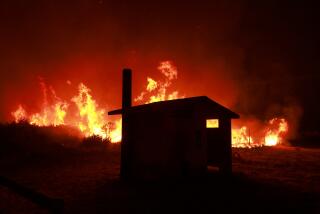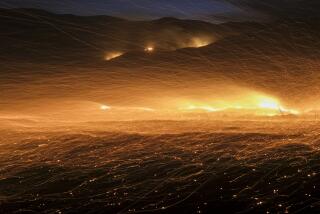RAWS Data
- Share via
SANTA CLARITA — High on a ridge overlooking the Antelope Valley sits a critical weapon in Los Angeles County’s firefighting arsenal.
But it looks more like a post-apocalyptic sculpture of a brontosaurus than a key element of firefighting. Surrounded by a chain-link fence topped with barbed wire, the Remote Automated Weather Station--or RAWS as its keepers call it--transmits data on the hour to a satellite high above earth.
With the busiest months of the fire season fast approaching, the nine remote weather station units stationed countywide will become especially important in fighting fires. County fire officials consider the units so valuable that four more, about $18,000 each, are expected to be installed by year’s end.
“It takes measurements of wind speed and direction, rainfall, relative humidity, temperature, fuel moisture and fuel temperature,” said Deputy Forester Jose de Jesus Lopez, who monitors the existing stations. “We can make staffing decisions based on the fire danger levels.”
Weather, say fire officials, can be the most critical factor in how a fire behaves.
Predictions about fire danger are based on the amount of moisture in ground vegetation, called fuel moisture levels, and weather forecasts.
This year has been a mixed bag for fire forecasters. The wet El Nino winter has made some officials nervous because of the increased plant growth, particularly in fire-prone mountain regions throughout the Los Angeles area.
But more rainfall and humidity have kept those plants at above-average fuel moisture levels, according to Los Angeles County Fire Department data. The more moisture in plants, the less likely a fire will spread quickly and easily.
“Right now we should pretty much be able to handle a fire if it breaks out,” said Capt. Tom Crowley of the Los Angeles Fire Department. “But if we don’t get rain and it stays hot, it’s just all going to dry up.”
*
The uncertainty of the coming weeks is part of the reason Crowley and the firefighters at Fire Station No. 108 on Mulholland Drive in Sherman Oaks participated in a brush-fire drill Friday with other companies from Sherman Oaks, Beverly Hills, Bel-Air, Hollywood Hills, Westwood, Hollywood and West Los Angeles. More drills were scheduled over the weekend in the Little Tujunga area.
The best time to practice, Crowley said, is before real danger strikes.
“Once the Santa Ana winds start pushing the fires, we’ve learned not much will stop it except the ocean,” said Crowley, who has been a firefighter 26 years.
The fire drills and weather forecasting equipment are part of the increasingly sophisticated firefighting efforts in Southern California. County fire officials last month acquired a portable weather station they can take to ground zero at fires where the heat and intensity often create their own weather system.
*
But some of the tools firefighters use to make staffing decisions haven’t changed much over the years. At Fire Station No. 108 every afternoon, wood sticks are weighed to check the accumulation of moisture in the last 24 hours. The findings are used in connection with readings from other parts of the city, as well as information from the county to issue daily fire danger reports. Fuel moisture levels in the brush at 18 sites throughout the county are checked at the same time every two weeks by the same county fire deputy to assure accuracy. The resulting fire maps show the areas most at risk for quick-spreading fire.
At the same time that fuel moisture readings take the pulse of fire danger, county and city officials continue to work to enforce brush clearance requirements.
This year, with the required clearance extended from 100 to 200 feet around structures, city fire officials have inspected 165,000 properties and issued 21,000 notices of noncompliance. At least 7,000 of those cited have since cleared their lots, said Fire Capt. Paul Quagliata, head of the city’s brush clearance unit.
*
“We’ve had a lot of resistance this year,” Quagliata said, “mostly because of the increased cost of clearing more land.”
County fire officials said so far this year they have a 75% compliance rate of the more than 31,000 properties that were sent notifications requiring brush clearance.
Such brush removal is considered essential to reducing fire risk and damage, especially in densely populated mountain communities in the Santa Monica Mountains, Baldwin Hills and the Mt. Washington/El Sereno area.
Clearing as much brush as possible this year is also important for future fire safety. The effects of El Nino may be felt even more next year, said Chief Herb Spitzer of the Los Angeles County Fire Department’s forestry division.
“I’ve looked at the records dating back to 1919 and they show that the year after the heavy rainfall is always worse for fires,” said Spitzer.
How much worse?
“The year after an El Nino year we see an 85% increase in fires and 293% increase in acreage burned,” Spitzer said. “This fire season shouldn’t be as intense as it typically is, but next year could be terrible.”
* Gearing Up for Fire Season
Valley Briefing, B2
More to Read
Sign up for Essential California
The most important California stories and recommendations in your inbox every morning.
You may occasionally receive promotional content from the Los Angeles Times.














